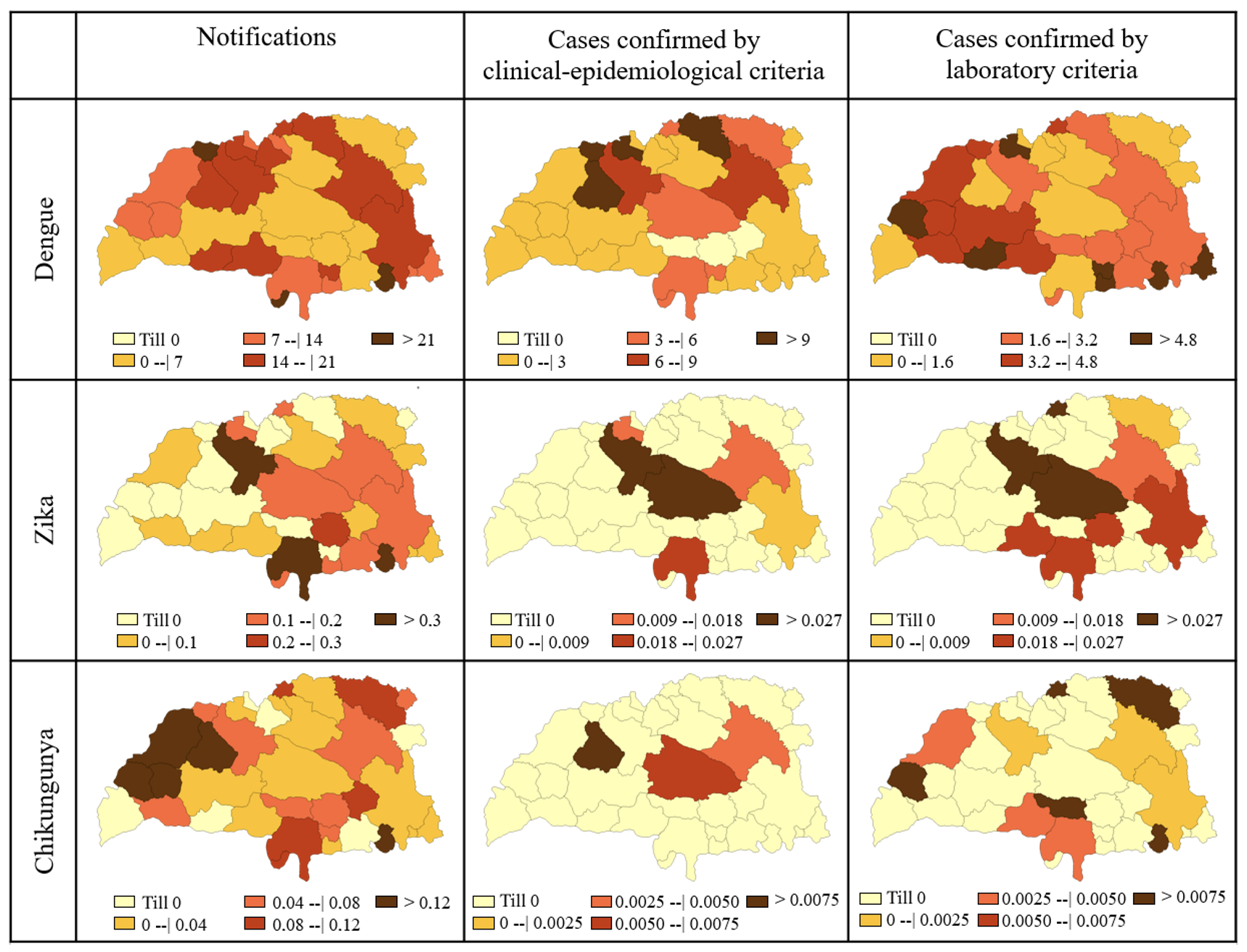Epidemiological Analysis of Arboviruses in the Triângulo Mineiro from 2014 to 2018
Main Article Content
Abstract
Objective: To study the pattern of presentation of arbovirus cases in the Triângulo Mineiro region, Minas Gerais, Brazil. Methods: Cross-sectional, descriptive study with quantitative analysis of data obtained from the Information System of Notifications of Diseases of the Ministry of Health from 2014 to 2018. Results: 106,040 cases of Dengue, 1,691 of Zika, and 421 of Chikungunya were reported. The year with the most Dengue and Zika notifications was 2016; Chikungunya was in 2017. The municipalities with the highest incidence were Água Comprida, Gurinhatã and Araporã, while the lowest were Cascalho Rico, Indianópolis and Cachoeira Dourada. There were more reports from adult females. Conclusion: In the studied region, there was the simultaneous circulation of the three investigated arboviruses, especially Dengue, similar to other Brazilian regions. This study can contribute to planning public policies for the prevention and control of arboviruses.
Article Details
Authors maintain copyright and grant the HSJ the right to first publication. From 2024, the publications wiil be licensed under Attribution 4.0 International 
 , allowing their sharing, recognizing the authorship and initial publication in this journal.
, allowing their sharing, recognizing the authorship and initial publication in this journal.
Authors are authorized to assume additional contracts separately for the non-exclusive distribution of the version of the work published in this journal (e.g., publishing in an institutional repository or as a book chapter), with acknowledgment of authorship and initial publication in this journal.
Authors are encouraged to publish and distribute their work online (e.g., in institutional repositories or on their personal page) at any point after the editorial process.
Also, the AUTHOR is informed and consents that the HSJ can incorporate his article into existing or future scientific databases and indexers, under the conditions defined by the latter at all times, which will involve, at least, the possibility that the holders of these databases can perform the following actions on the article.
References
Lopes N, Nozawa C, Linhares REC. Características gerais e epidemiologia dos arbovírus emergentes no Brasil. Rev Pan-Amaz Saúde. 2014;5(3):55-64. https://doi.org/10.5123/S2176-62232014000300007
Donalisio MR, Freitas ARR, Von Zuben APB. Arboviruses emerging in Brazil: challenges for clinic and implications for public health. Rev Saude Publica. 2017;51:30. https://doi.org/10.1590/s1518-8787.2017051006889
Lima-Camara TN. Emerging arboviruses and public health challenges in Brazil. Rev Saude Publica. 2016;50:36. https://doi.org/10.1590/S1518-8787.2016050006791
Brasil, Ministério da Saúde. Boletim Epidemiológico no.10. 2019;50:1-13.
Teich V, Arinelli R, Fahham L. Aedes aegypti e sociedade: o impacto econômico das arboviroses no Brasil. J Bras Econ Saúde. 2017;9(3):267-76. https://doi.org/10.21115/JBES.v9.n3.p267-76
Brasil, Ministério da Saúde, Secretaria de Vigilância em Saúde. Guia de vigilância em saúde. 5ª ed. Brasília, DF: Ministério da Saúde; 2014 [cited 2022 May 30]. 126 p. Available from: https://bvsms.saude.gov.br/bvs/publicacoes/guia_vigilancia_saude_5ed.pdf
Associação Mineira de Municipios. Caracterização econômica das regiões de planejamento [Internet]. 2014 [cited 2022 May 30]. Available from: https://bit.ly/38S2AWv
Brasil, Instituto Brasileiro de Geografia e Estatística. Estimativas da População. [Internet] [cited 2022 May 30]. Available from: https://bit.ly/3z2mKYp
Brasil, Conselho Nacional de Saúde. Resolução no 466, de 12 de dezembro de 2012. Braslília, DF: Diário Oficial da União; 2012 [2013 Jun 13; cited 2022 May 30].Available from: https://bit.ly/3x152Se
Honório NA, Câmara DCP, Calvet GA, Brasil P. Chikungunya: uma arbovirose em estabelecimento e expansão no Brasil. Cad Saude Publica. 2015;31(5):906-8. https://doi.org/10.1590/0102-311XPE020515
Campos GS, Bandeira AC, Sardi SI. Zika virus outbreak, Bahia, Brazil. Emerg Infect Dis 2015;21:1885-16. https://doi.org/10.3201/eid2110.150847
Oliveira RMAB, Araújo FMC, Cavalcanti LPG. Aspectos entomológicos e epidemiológicos das epidemias de dengue em Fortaleza, Ceará, 2001-2012. Epidemiol Serv Saude. 2018;27(1):e201704414. https://doi.org/10.5123/S1679-49742018000100014
Porto WL, Terto TF, Soares LC, Aguiar Cardoso AC, Castro Alencar VM, Da Silva BAK, et al. Cenário epidemiológico das arboviroses no Piauí. Rev Eletrônica Acervo Saúde. 2019;11(14):e1054. https://doi.org/10.25248/reas.e1054.2019
Monteiro ESC, Coelho ME, Cunha IS, Cavalcante MAS, Carvalho FAA. Aspectos epidemiológicos e vetoriais da dengue na cidade de Teresina, Piauí - Brasil, 2002 a 2006. Epidemiol Serv Saúde. 2009;18(4):365-74. https://doi.org/10.5123/S1679-49742009000400006
Avelino-Silva VI, Ramos JF. Arboviroses e políticas públicas no Brasil [Editorial]. Rev Ciênc Saúde. 2017;7(3):1-2. https://doi.org/10.21876/rcsfmit.v7i3.675
Páscoa FRB, Gonçalves NA, Magalhães AMBC, Gurgel SCV, Filizola LRM, Farias CMNE. Análise da consistência dos bancos de dados das arboviroses em uma Unidade de Saúde em Fortaleza-CE. Rev Saúd Digi Tec Edu [Internet]. 2018 [cited 2022 May 30];3(4):18-31. Available from: http://www.periodicos.ufc.br/resdite/article/view/39698
Brasil, Conselho Nacional de Secretários de Saúde. Vigilância em saúde: parte 2. Vol. 6, Coleção Para Entender a Gestão do SUS. Brasília: CONASS; 2011. Available from: https://bit.ly/3GAOi9a
